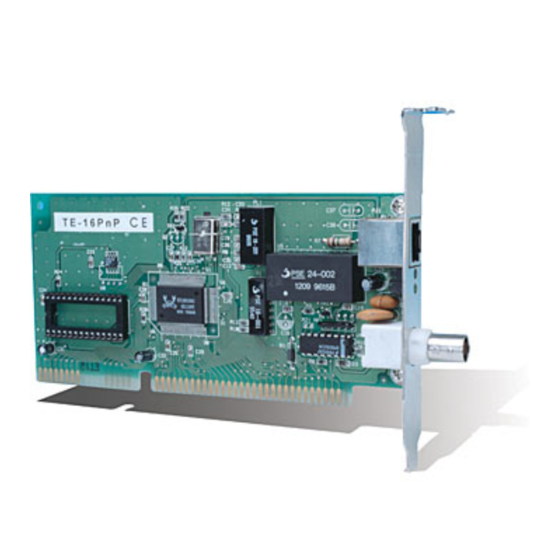
Advertisement
TE-16PnP User's Guide
Oct. 1995
Trademarks
Brand and product names used in this guide are trademarks and/or registered trademarks of their
respective companies.
FCC Certification
• TE-16PnP FCC Class B ID : KA2APC20001
This device complies with Part 15 of the FCC Rules. Operation is subject to the following two
conditions: (1) this device may not cause harmful interference, and (2) this device must accept
any interference received, including interference that may cause undesired operation.
Warning
This equipment has been tested and found to comply with the limits for a Class B digital device,
pursuant to Part 15 of the FCC rules. These limits are designed to provide reasonable protection
against harmful interference in a residential installation. This equipment generates, uses and can
radiate radio frequency energy and, if not installed and used in accordance with the instructions,
may cause harmful interference to radio communications. However, there is no guarantee that
interference will not occur in a particular installation. If this equipment does cause harmful
interference to radio or television reception, which can be determined by turning the equipment
off and on, the user is encouraged to try to correct the interference by one or more of the
following measures:
• Reorient or relocate the receiving antenna.
• Increase the separation between the equipment and receiver.
• Connect the equipment into an outlet on a circuit different from that to which the receiver is
connected.
• Consult the dealer or an experienced radio/TV technician for help.
Shielded interface cables must be used in order to comply with emission limits.
Features
Advertisement
Table of Contents

Summary of Contents for TRENDnet TE-16PNP
- Page 1 If this equipment does cause harmful interference to radio or television reception, which can be determined by turning the equipment off and on, the user is encouraged to try to correct the interference by one or more of the following measures: •...
- Page 2 • Support for 8-bit and 16-bit expansion slots: The cards can be used in 8-bit (the sort XT- style) or 16-bit (AT-style) expansion slots. The card automatically detects the type of slot being used.
- Page 3 You can touch the metal chassis of your computer, and maintain grounding by wearing a wrist strap attached to the chassis. 1. Turn off your computer and then install the adapter into an empty 8 or 16 bit slot. 2. Connect the computer to a network.
- Page 4 Setup Program This program comes in a diskette with the adapter package. To run, type the following at the DOS prompt > A:\UTILITY\TE16PNP The main menu appears with the following options: • Setup Configuration. Lets you specify the connector type, I/O base address, interrupt number, boot ROM starting address, and whether or not to enable the remote boot function.
- Page 5 Before you could use an adapter in a certain networking environment, you need to install first its driver program for that type of environment. Otherwise, the adapter will not operate properly. • NetWare 2.x, 3.x, 4.x ODI driver (client and server) •...






Need help?
Do you have a question about the TE-16PNP and is the answer not in the manual?
Questions and answers